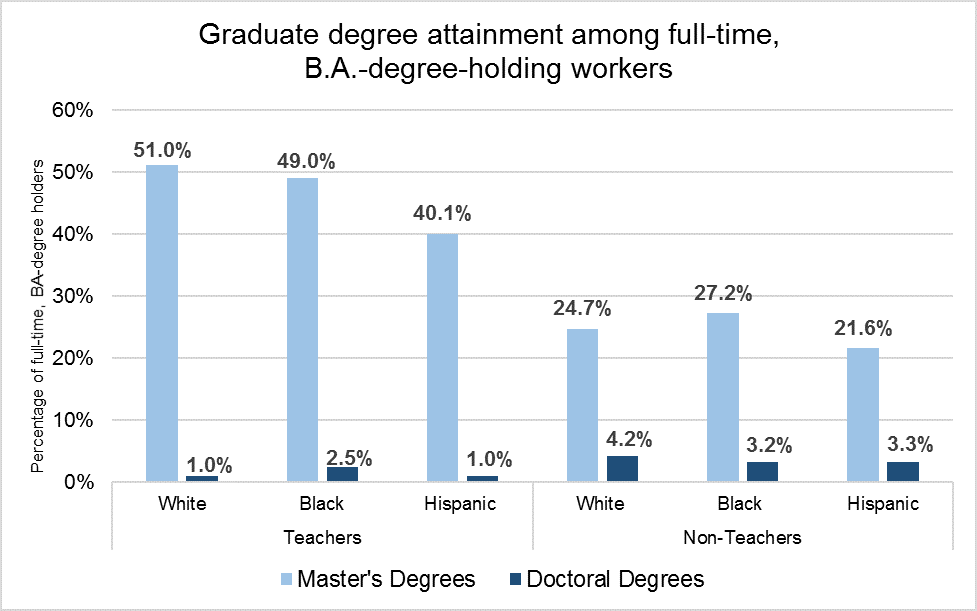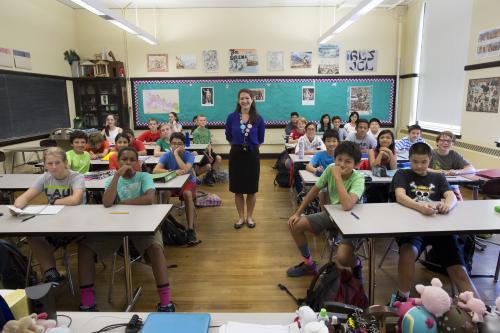This post is part of “Teacher diversity in America,” a series from the Brown Center on Education Policy that examines minority underrepresentation among public educators in the U.S.
Last week, the Brown Center on Education Policy at Brookings released a new report examining inequalities in teacher salaries across the nation and how they are related to state-level inequalities in school funding and pension benefits. We found the level of wage inequality among public school teachers is generally low, and only a very small share of this inequality (less than 1 percent) is related to different racial/ethnic groups among teachers.
This low level of inequality related to race is not too surprising in light of the fact that 89 percent of public teachers are compensated according to salary schedules, which are explicitly designed to not differentiate teacher pay by race, gender, or other differentiating factors (e.g., the school you teach in, or the grade of students you teach).
This finding, however, may be somewhat counterintuitive when viewed through the lens of teacher diversity. The teaching profession suffers from a well-known diversity problem. While minority groups account for roughly half of the current population of public school students, minority teachers comprise just 18 percent of the public teacher workforce, a diversity gap larger than expected based on racial differences in bachelor’s degree attainment alone.
If pay is essentially equal by race, then what might account for the diversity gap? Structural barriers into the workforce are almost certainly playing a role. For example, prior work has shown differential passage rates on teacher licensure exams (even though teacher performance itself shows no difference by race). Bias by hiring schools, whether explicit or implicit, may be at play in decisions to hire and assign teachers to schools as well. Based on what we learned from our investigation to produce this report, we suspect graduate degrees may also form a type of indirect structural barrier for entry into the teacher workforce, at least among Hispanics. Let’s explain how this might play out.
Educational attainment and salary, by race
How might advanced degrees form a structural barrier to diversity? As we found in the report, the rewards to having an advanced degree are greater among public school teachers than in other comparison occupations. A master’s degree may advance a teacher’s salary up to $5,000 even in their first year on the job. The National Council on Teacher Quality estimated an 11 percent bump in pay, on average, for teachers holding a master’s degree in the 100 largest school districts in the U.S. in 2010.
In a profession widely perceived as underpaid, earning an advanced degree is one of the few viable paths a teacher has to increasing his or her career earnings. Yet, educational attainment among minority groups lags behind whites (and Asians). Moreover, because minority students take on increasingly more loans to get through their bachelor’s degree to begin with, they may be loath to commit to a profession that requires an even greater student loan balance to increase their paychecks.
To investigate further, we used the 2015 American Community Survey to tabulate differences in graduate degree attainment by race among all full-time workers with at least a bachelor’s degree, and then specifically among teachers. Figure 1 presents the results.

Investigating among teachers only, we found only subtle differences in graduate degree attainment between black and white teachers—slightly more white teachers held master’s degrees and slightly fewer held doctoral degrees, in comparison to black teachers. This is, perhaps, surprising to some, given well-documented gaps in educational attainment by race; however, these well-known gaps are based on overall population figures, while Figure 1 looks at educational attainment specifically among those holding a B.A. degree.
Even among B.A.-holding workers, though, we still see a consequential gap for Hispanic teachers—while their doctoral degree attainment is almost on par with white teachers, their master’s degree attainment lags behind black teachers by 9 percentage points.
Comparing teachers’ graduate degree attainment with full-time B.A.-holders in other professions, it is clear that teachers earn master’s degrees at far higher rates—almost double—than their race’s non-teacher group. Yet, doctoral degree attainment is notably higher among non-teachers than teachers. And interestingly, the racial gap in graduate degree attainment, while largest between Hispanics and the two other races combined, is notably smaller than the analogous gap observed among teachers.
This evidence of graduate degree gaps by race suggests an indirect way wage differential could potentially play out are through the implicit requirement to earn an advanced degree to persist in the profession. Though based on the gaps in Figure 1, it will likely be a gap observed among Hispanics relative to white and black teachers.
To confirm this, we went further and conducted a Oaxaca decomposition on the (admittedly small) wage gap between white and black and then white and Hispanic teachers.[1] As suspected, we found differences in advanced degrees explained none of the white-black gap, but more than 50 percent of the white-Hispanic wage gap.
Breaking down structural barriers
Though this analysis in not conclusive, it suggests that rewarding so heavily for advanced degrees could differentially impact some racial groups, notably Hispanics. Therefore, these actions could implicitly discourage them from pursuing (or staying in) a career in teaching and contribute, in part, to the yawning diversity gaps in the profession.
With many studies showing an advanced degree does not predict a teacher’s future performance, this evidence further challenges the practice of tying so much of teachers’ compensation to graduate degree attainment, which our new report shows is notably higher among the teaching profession than most other comparison occupations. Practitioners and policymakers interested in promoting a teacher workforce more representative of the students they serve should pay attention.
Caitlin Dermody contributed to this post.
Footnote
- This is an econometric technique to break out wage gaps between groups into that which is based on differences in the composition of the groups (here, focused on graduate degree attainment) versus difference from other unobservable sources.








Commentary
How extra pay for graduate degrees may influence the teacher diversity gap
September 14, 2017